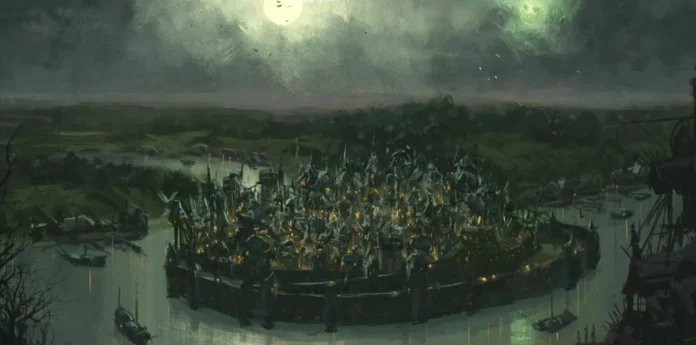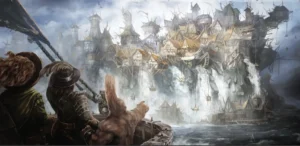We’ll be starting the first of our series on published RPG campaigns with Warhammer Fantasy Roleplay’s The Enemy Within; oft described as the “best campaign ever written”. A bold claim, but does it stand up? And fair warning; if you’re a player of this campaign, prospective or current; Go away, or may your rolls forever be fumbles. While I don’t intend to go into high detail on plot elements I also won’t be avoiding them.
Initially published starting in 1986 for WFRP 1e, The Enemy Within was originally written in six parts: The Enemy Within (sometimes called Mistaken Identity), Shadows over Bögenhafen (there’s an amusing accidental history to this name, but I won’t relate it here), Death on the Reik, Power Behind the Throne, Something Rotten in Kislev, and Empire in Flames.
The most recent iteration was for WFRP 4e, and involved a rewrite of the latter portion of the campaign, owing to general widespread dissatisfaction with the original story.
In its current 4th edition form, TEW is divided into: Enemy In Shadows (containing Mistaken Identity and Shadows over Bögenhafen), Death on the Reik, Power Behind the throne, The Horned Rat (a replacement for Something Rotten in Kislev), and Empire in Ruins. Each book also has an associated (but sold separately) companion book, covering greater world detail and rules relevant to that part of the campaign, such as river trading rules in the Death on the Reik Companion. That’s quite a lot of books to invest in at about £19-20 a book, though the companion pieces aren’t absolutely required for the running of the campaign.
In brief, the overall plot of The Enemy Within revolves around the machinations of certain cults (with one in particular taking central plot focus) dedicated to the Chaos God Tzeentch in their plans to infiltrate, undermine, and erode the purity and direction of Sigmar’s Holy Empire. As with any good handful of cults, their efforts are mutually exclusive and often in direct opposition, fitting the labyrinthine plans within plans of the Lord of Change.
The player characters stumble upon one of these small plot threads quite by accident, and become drawn into a plot with ever escalating consequences and scope.
While it isn’t always completely effective at getting it across, the central theme of The Enemy Within is about hidden rot and corruption in society, lurking beneath the surface of a civil and functional veneer, growing in secret until it’s too late to do anything about it; most would rather bury their heads, assuming the glorious and all powerful Empire couldn’t possibly be taken over from a hidden enemy wearing a smile on its face. Which is why you can do a lot with the arrogance and complacency of figures in power as a theme, as well.
As with any published campaign of this type, the first thing you’ll *need* to do is read it over. Then read it again. Commit the plot structure to memory as much as you possibly can; though of course you can’t recall everything in picture perfect detail, you should know the spine of the plot pretty thoroughly.
Then, as you approach actually playing each part of the campaign, you’ll want to read that particular chapter over again, to keep it as fresh and detailed as possible. Make notes of your own, and particularly keep track of pages you’ll need to reference a lot with bookmarks or more succinct summaries of your own (I find bullet points shortened for brevity with page number references to be useful).
This campaign does come with some pregenerated characters, though I’d personally dismiss them in favour of the players making their own characters and hooking their backstories and motivations into both campaign set up and future campaign points; replace NPCs with their significant background characters, make your players’ character feel like living parts of the world.
After all, while some might rail against any kind of narrowing of character options, I don’t think it’s inappropriate or unfair to forewarn players, with as much detail as you can, what kind of characters might fit the campaign and which might not, though a bit of creative thinking and flexibility can allow for a very broad range.
That said, if at least one of the players wants their character to be a wizard, then it’ll offer you all kinds of ways to hook them into the plot, particularly if they’re angling to be a college magister (which would effectively make half of the central plots the wizard character’s contractually obligated day job, a fact that’s never not useful).
If you’re thinking this sounds like a lot of work, then you aren’t wrong. This is, unfortunately, one of the weaknesses of this campaign; it was written at a time when this hobby was much less developed than it is, and there is a lot of railroading in this plot, and other design sensibilities of the 1980s. But you can make it work with enough preparation.
Should you need to, though? At that point, however, I understand why people might just want to write their own campaign. Particularly when there’s more than one plot element introduced early in this campaign that simply gets dropped by the end, which leaves you to either weave it back into the narrative, or cut it out and fix around the hole it leaves.
Does it stand up to its reputation as being the “best campaign of all time”? No, I don’t think it does. But is it still worth playing? Yes, absolutely!
I can say with honesty that, having run this campaign, it was some of the most fun I and my gaming group have ever had.
If you’re a fan of Warhammer Fantasy Roleplay, the chances of you not already knowing this are infinitesimally small, but if you’d somehow never heard of it, or you’re only just getting into WFRP, then you should certainly give this one a look.
Help keep news FREE for our readers
Supporting your local community newspaper/online news outlet is crucial now more than ever. If you believe in independent journalism, then consider making a valuable contribution by making a one-time or monthly donation. We operate in rural areas where providing unbiased news can be challenging. Read More About Supporting The West Wales Chronicle























